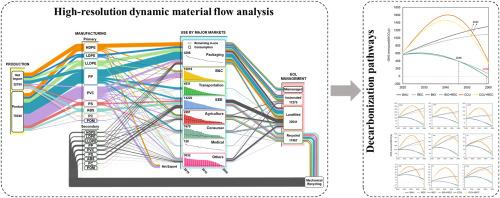塑料工业的高分辨率脱碳路径:基于生产、生活和生态系统的循环联动
IF 10
1区 环境科学与生态学
Q1 ENGINEERING, ENVIRONMENTAL
引用次数: 0
摘要
塑料工业的快速发展导致大量温室气体(GHG)排放。在这项研究中,我们开发了一个高分辨率的塑料动态物质流分析模型,整合了生命周期评估和情景分析方法,量化了塑料工业中与五种脱碳途径相关的温室气体排放。结果表明,到2060年,中国塑料工业的温室气体排放量将达到1.2968亿吨。提高生物系统内的塑料回收率可以减少15.7%的排放量。利用生产系统中的二氧化碳作为原料会导致更高的累积温室气体排放,而替代生态系统中的生物质可以在2059年实现碳中和,到2060年温室气体排放量为负3960万吨。此外,脱碳途径因不同的塑料类型而异。因此,综合考虑生产、生活和生态系统的多种脱碳策略,对评估塑料行业的减排潜力至关重要。本文章由计算机程序翻译,如有差异,请以英文原文为准。

High-resolution decarbonization pathways for the plastics industry: Based on the circular linkage of production, living, and ecological systems
The rapid development of the plastic industry has led to substantial greenhouse gas (GHG) emissions. In this study, we developed a high-resolution dynamic material flow analysis model for plastics, integrating life cycle assessment and scenario analysis methods to quantify the GHG emissions associated with five decarbonization pathways in the plastics industry. The results indicate that China's plastics industry GHG emissions will reach 1296.8 million tonnes (Mt) by 2060. Increasing plastic recycling rates within the living system can reduce emissions by 15.7 %. Utilizing CO2 from the production system as a feedstock results in higher cumulative GHG emissions, while substituting biomass from the ecological system can achieve carbon neutrality by 2059, with negative GHG emissions of 39.6 Mt by 2060. Moreover, decarbonization pathways vary across different plastic types. Therefore, a comprehensive approach that integrates multiple decarbonization strategies across the production, living, and ecological systems is essential to evaluate emission reduction potential in the plastics industry.
求助全文
通过发布文献求助,成功后即可免费获取论文全文。
去求助
来源期刊

Journal of Cleaner Production
环境科学-工程:环境
CiteScore
20.40
自引率
9.00%
发文量
4720
审稿时长
111 days
期刊介绍:
The Journal of Cleaner Production is an international, transdisciplinary journal that addresses and discusses theoretical and practical Cleaner Production, Environmental, and Sustainability issues. It aims to help societies become more sustainable by focusing on the concept of 'Cleaner Production', which aims at preventing waste production and increasing efficiencies in energy, water, resources, and human capital use. The journal serves as a platform for corporations, governments, education institutions, regions, and societies to engage in discussions and research related to Cleaner Production, environmental, and sustainability practices.
 求助内容:
求助内容: 应助结果提醒方式:
应助结果提醒方式:


